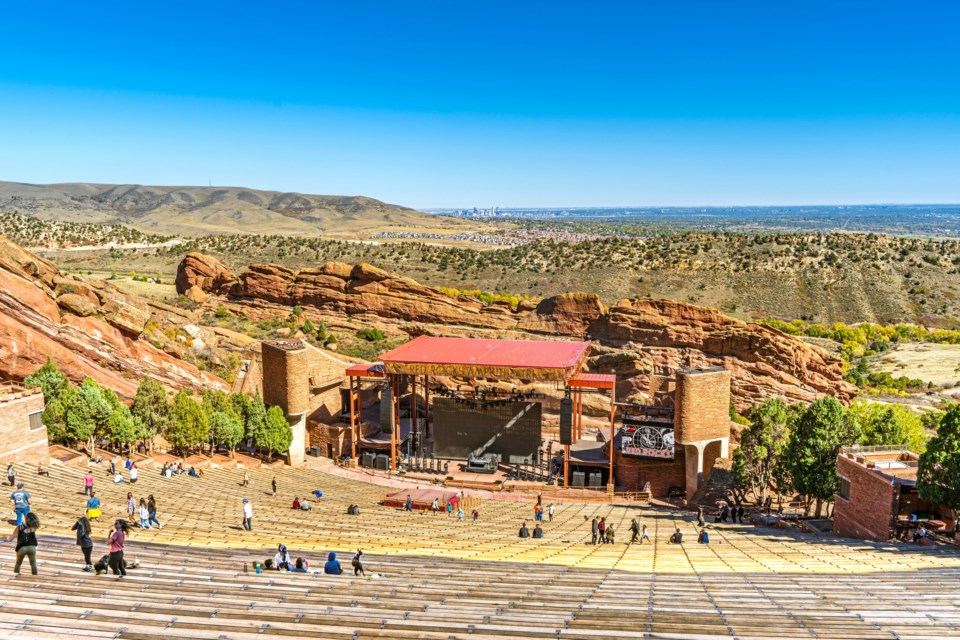When David Glade built his Morrison home eight years ago, he added extra insulation to help absorb the sound coming from a very famous neighbor. Glade’s house has an unobstructed view of Red Rocks Amphitheater.
The measures he took during his home construction included adding foot-thick insulation and hurricane-proof French doors that were advertised as soundproof. On concert nights, he also wears earplugs in bed. None of it has been enough.
“I still get all the bass,” he said. “I’m a light sleeper, so I just sit up and wait for it to be done. But last year, when they went into mid-November, it was kind of wearing on me.”
The Morrison Town Board talked about the venue’s double-edged impacts on the town during its last meeting. Glade, a software engineer who worked with Red Rocks consultants on a previous noise impact study, presented the board with a report on the venue Feb. 6. It touched on the increase in concerts, concerns about lighting and decibel levels.
While Red Rocks’ concerts feed the small town’s economy, concert-goers also jam Morrison’s streets, venue lights illuminate its night skies and the bands fill the nights with sound that often echoes through the valley.
Further exacerbating the issues, concerts used to happen primarily in the summer. Today, Red Rocks’ season extends nearly eight months — from the end of March to mid-November, and those months are busy. About 200 concerts are planned in 2024.
The world-renowned amphitheater draws people for more than just concerts. It also hosts Yoga on the Rocks, Film on the Rocks and high school graduations, and draws a steady stream of tourists and day users.
“We love Red Rocks,” said Morrison Mayor Chris Wolfe. “A lot of the local businesses rely on it, and we are benefitting from the additional shows. But sometimes there’s fallout. It has a big impact.”
Representatives of both the City of Denver-owned Red Rocks and the Town of Morrison both say they’ve enjoyed a historically good working relationship.
Red Rocks Venue Director Tad Bowman expects that will continue.
“We work collaboratively with the town on a regular basis, and will continue to work where we can to make those things work,” he said. “It’s a balancing act managing a venue that’s world-renowned with trying to be good neighbors.”
Glade agreed.
“Tad is easy to work with, and he’s trying to balance between the promoters and artists,” he told the town board. “I just wanted to keep this on the radar. It seems like in the last few years we’ve started amping up (volume) and also the number of concerts.”
Constantly improving technology means sound systems are getting better, he said.
“The acoustics, the speakers and sound systems … everything is getting better and more efficient,” he said. “They’re able to pump out sounds they were never able to produce before and do it at an incredible volume.”
The two entities have worked together to address issues in the past.
In 2013, Morrison residents voiced similar concerns. Red Rocks hired acoustical consulting firm K2 for a nearly four-year noise study and added new rules that included a decibel limit and fines for exceeding it.
In 2022, Red Rocks and Morrison negotiated an impact fee, which is primarily used for the town’s law enforcement.
The fee, adjusted based on the consumer price index, generated $180,00 in 2023. It’s expected to bring in $220,000 in 2024.
Some Morrison trustees said it’s not enough.
“Morison has 125 households; we don’t have the tax base to support the level of law enforcement we need,” said Town Trustee Katie Gill. “We have 200-plus shows a year there now as opposed to 30 when I moved here.”
“They’ve quadrupled the number of shows,” said Trustee John Leonard. “The impact is dramatic to us. We’re due something.”
Trustee David Wirtz said lights from the amphitheater, which remain on well after the concerts as crews clean up, also have a negative impact.
“It’s like a Christmas tree up there,” he said. “Most of the town is below the amphitheater; it’s like a set of headlights pointing into our houses.”
Glade’s report to the town board concluded with some recommendations, including the adoption of concert cut-off time similar to Fiddler’s Green Amphitheatre.
The smaller Greenwood Village venue requires its weekend concerts to end at 11:15 p.m., as opposed to Red Rocks’ midnight.
It also recommends stricter sound level restrictions, establishing a Red Rocks Concert Noise Complaint Line, adopting dark sky recommendations for outdoor lighting and changes in traffic to reduce congestion.
Bowman said Red Rocks keeps close tabs on performers’ decibel levels.
“We are very diligent about monitoring the sound levels with the equipment we have and enforcing the limits,” he said.
He said outdoor lighting at the amphitheater is largely unchanged, though some downcast lighting was added along the roads a couple of years ago to help concert-goers get safely to and from cars.
The increase in shows, he said, is driven by concert lovers.
“If there wasn’t demand, they wouldn’t have the shows,” said Bowman, who on Feb. 12 attended a Country Music
Association event at which Red Rocks was named “venue of the year.” “Red Rocks regularly enjoys that sort of recognition. And that’s going to certainly impact and drive some demand.”
While the venue’s season has extended to include late fall and early spring, Bowman said it will never be a year-round venue.
Evergreen-based Canyon Courier is one of two dozen Colorado Community Media newspapers that serve Denver metro area.



